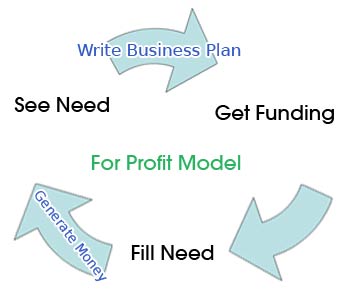 |
An economic institution creates something of value. The assumption . . . is that nonprofits have measurable economic value – even if the measure is imperfect. Herrington J. Bryce
Moving to an Investment-Based Mindset An excerpt from ROI for Nonprofits: The New Key to Sustainability by Tom RalserAn early experience with a particular fundraiser was unique in that they had just begun using a direct solicitation model, rather than a volunteer-driven model. It couldn’t have been a better learning experience. Most fundraising has traditionally been volunteer-driven, that is to say that people within the NPO, board members, committee members, and staff, shouldered the burden of actual solicitations. The announcement of an organization launching a capital campaign was often met with groans by both the board and staff, since they knew how much work it involved. The volunteer model of fundraising did not lend itself to an investment-driven mindset because of the structure of the model itself. It employs a sort of multi-level marketing approach that takes a lot of time and people. Many refer to this as the “coaching”, and sometimes the “cheerleading” model, depending on their distaste for the methods. It typically involves gathering people in a room, briefing them on how to approach their peers, associates, or targeted list of prospects, giving them a pep talk, and unleashing them on the community. When that particular group raised the requisite amount of money, other groups were dispatched, until the money was raised. The late eighties and early nineties ushered in a new model that was not only my first exposure to the intricacies of a capital campaign, but the advantages of a professional solicitation model. In this model, outside professionals are used to make the actual “ask.” It has many advantages, such as a more consistent message, less strain on personal relationships, and less staff time. As you can imagine, it also costs more initially, but it does produce impressive results. The volunteer model, with its dependence on relationships, emotional appeals, and often arm-twisting, does not need to adopt an investment-driven approach to be successful. The professional solicitation model, since it relies less on personal relationships, is almost forced to adopt an investment-driven mindset. Being repeatedly asked “What’s in it for me?” serves to hone the answer, since no money is raised if the answer is not satisfactory. Nonprofit vs. For-profit Models The nonprofit funding model and the for-profit funding model are very similar in the early stages. They both see a need, secure funding, and fill the need. That is where the similarities end. After seeing a need, the nonprofit organization, or NPO, typically writes a grant. If the grant application is funded, the NPO goes about spending the funds and filling the need. The disruption in the funding cycle occurs when the grant runs out, or must be reapplied for on a continual basis. This is the situation faced by many NPOs.
Exhibit 4.1
The Nonprofit Model 
The for-profit model, on the other hand, does not have the opportunity to participate in the grant process. If, in the process of filling the need, they do not do it in such a way that allows the product or service to pay for itself, and generate a fair profit, the marketplace will put them out of business.
Exhibit 4.2
The For-profit Model 
NPO’s are very good at filling the need, but are often less adept at:
If this demonstration and communication gap can be bridged, the private sector can then be cultivated to become investors in the NPO that provides something of value to them. |

